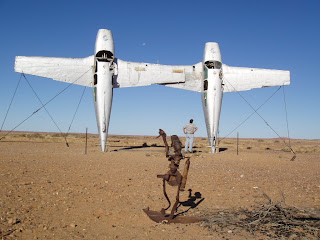Our first priority was for our daily caffeine fix. So as we did yesterday afternoon, we returned to the Quandong Cafe for a cappuccino and raison toast. After having a nice morning tea and chat to the manageress, we refuelled the Bravo as one never is sure when the next fuel stop may be. The price is more expensive than we have paid so far. This is to be expected as we are starting to get into more out of the way locations.
After fuelling ourselves and the Bravo, we made our way onto the Marree road and travelled only a few kilometres to the Leigh Creek coalfields.
 This is a massive area and sends about 10000 tonnes of brown coal south each day. It has been mined extensively since the early 1940s and is expected to last for many years yet. There is a lookout over the mine and parked there is a retired dragline and dump truck. They are massive but small compared to today’s equipment.
This is a massive area and sends about 10000 tonnes of brown coal south each day. It has been mined extensively since the early 1940s and is expected to last for many years yet. There is a lookout over the mine and parked there is a retired dragline and dump truck. They are massive but small compared to today’s equipment.Our next stop was brief one in Lynhurst. There is not too much here. Its origin was as a railway town. It is known as the gateway to the north east to Innaminka along the Strezlecki Track or north to Marree and the Birdsville and Oodnadatta Tracks. After collecting some items in the roadhouse, we moved on.
The next stop was the ruins of the ghost town Farina.
 It is now nothing more than a reason to walk along the self guided ruins. It was another railway town but since the demise of the railway it also died. It once boasted two hotels, police station, churches, school and even a brothel! It was once a place where the famous Sidney Kidman’s cattle were loaded bound for markets.
It is now nothing more than a reason to walk along the self guided ruins. It was another railway town but since the demise of the railway it also died. It once boasted two hotels, police station, churches, school and even a brothel! It was once a place where the famous Sidney Kidman’s cattle were loaded bound for markets.Once again we moved on seeing various ruins of the railway. There are numerous little rail sidings and water tanks that are no longer used.
We made Marree for our lunch break. It is a busy town with all the tourists around. We had lunch in the park beside the now unused railway station.
 The remaining lines have three retired Ghan locomotives and a few other items from those days. The little town is very tidy with a two story hotel that has extensive accommodation in ‘dongas’.
The remaining lines have three retired Ghan locomotives and a few other items from those days. The little town is very tidy with a two story hotel that has extensive accommodation in ‘dongas’.When we finished lunch, we made ourselves known to some Kimberley Kamper owners from Echuca in Victoria. We decided we would put the two Kampers together with our Karavan for a picture. There were two other Kampers around but not near us. The Kimberley Kampers are found in just about every stop over point.

Next we came to Alberrie Creek where the Muttonia Sculpture Park is situated. Mechanic turned artist, Robin Cooke, has turned recycled rubbish into amusing sculptures like the famous “Plane Henge” and the “Ghan Hover Bus” and many others.


Then we moved on to try to find a location to camp overnight in. Eventually, we found the Lake Eyre South Lookout. It looks north over the dry salt encrusted lake bed which rarely gets water in it. As far as one can see it is salt pan. This basin covers more than 1.1 million square kilometres and is the world’s largest drainage system. It has highly variable and unreliable inflows. We hope to see the remnants of the latest inflow in several days from William Creek.
We set up in the parking area thinking we would be totally alone for the evening but some Tasmanians pulled in. We chatted for a while before we all went inside our separate ‘homes’ to cook dinner. Prior to their arrival we had watched the sun set over the desert and had several red wines and nibbles before dinner.
Amazing colours appear when the sun sets with mauve blending into grey and then the moon shining brightly across the saltpan with not a cloud in sight.

Our first day has been completed on the Oodnadatta Track with about 2 more to go.
No comments:
Post a Comment